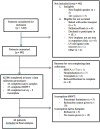Physiological and Psychological Stress in Patients Living With a Left Ventricular Assist Device
- PMID: 30199387
- PMCID: PMC6218313
- DOI: 10.1097/MAT.0000000000000847
Physiological and Psychological Stress in Patients Living With a Left Ventricular Assist Device
Abstract
Patients with a left ventricular assist device (LVAD) commonly experience psychological distress post-implantation, but physiological stress and differences by implant strategy remain unstudied. This study describes indicators of physiological (salivary cortisol, C-reactive protein, sleep quality) and psychological (perceived stress, depression, and fatigue) stress by implant strategy and examines relationships between stress and outcomes (quality of life [QOL] and functional status). Prospective, cross-sectional data were collected from patients ≥3 months post-LVAD implantation (n = 44), and descriptive statistics and logistic regression were used. The study sample was average age 57.7 ± 13 years, mostly male (73%), married (70.5%), and racially diverse. Median LVAD support was 18.2 months. Most had normal cortisol awakening response and fair sleep quality, with moderate psychological stress. There were no differences in stress by implant strategy. Normal cortisol awakening response was correlated with low depressive symptoms. Sleep quality and psychological stress were associated with QOL, whereas cortisol and C-reactive protein levels were associated with functional status. This is the first report of salivary biomarkers and stress in LVAD outpatients. Future research should examine physiological and psychological stress and consider potential clinical implications for stress measurement for tailored approaches to stress management in this population.
Figures




References
-
- Rose Ea, Gelijns AC, Moskowitz AJ, Heitjan D, Stevenson LW, Dembitsky W, et al. Long term use of a left ventricular assist device for end-stage heart failure. N Engl J Med. 2001;345(20):1435–1443. - PubMed
-
- McEwen BS, Stellar E. Stress and the individual. Mechanisms leading to disease. [Accessed July 16, 2014];Arch Intern Med. 1993 153(18):2093–2101. http://www.ncbi.nlm.nih.gov/pubmed/8379800. - PubMed
Publication types
MeSH terms
Grants and funding
LinkOut - more resources
Full Text Sources
Other Literature Sources
Medical
Research Materials

